IDEC1106 Fabric Worksheet: Detailed Analysis of Fibers and Fabrics
VerifiedAdded on 2022/09/27
|19
|2689
|25
Homework Assignment
AI Summary
This assignment is a comprehensive fabric worksheet designed to explore various aspects of textile materials. It begins with an introduction to fibers, differentiating between natural (like cotton and flax) and manufactured (like rayon and nylon) types, and discussing their properties. The worksheet then delves into weave structures, specifically twill and satin, and includes a diagram of fabric components. The assignment requires students to complete charts detailing the characteristics of different fabrics, including silk, acrylic, wool, cotton, viscose, and linen. Further sections focus on dying, printing, and finishes, as well as fabric specifications and cleaning codes. The student provides examples and detailed explanations, including a discussion of the history and applications of polyester, and comparisons between rayon and nylon. The work includes references to support the information presented, making it a thorough exploration of textile science and design.
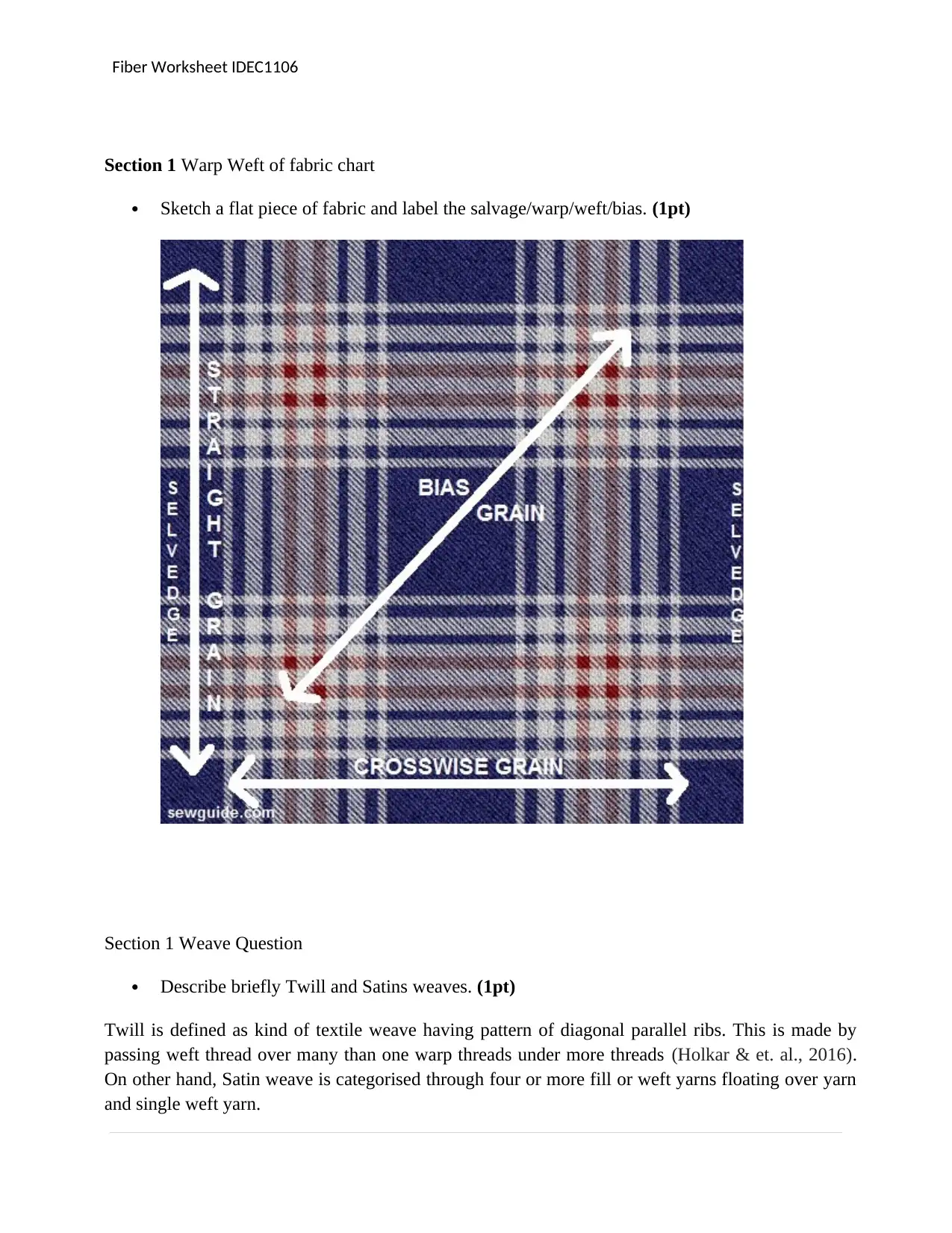
Fiber Worksheet IDEC1106
Section 1 Warp Weft of fabric chart
Sketch a flat piece of fabric and label the salvage/warp/weft/bias. (1pt)
Section 1 Weave Question
Describe briefly Twill and Satins weaves. (1pt)
Twill is defined as kind of textile weave having pattern of diagonal parallel ribs. This is made by
passing weft thread over many than one warp threads under more threads (Holkar & et. al., 2016).
On other hand, Satin weave is categorised through four or more fill or weft yarns floating over yarn
and single weft yarn.
Section 1 Warp Weft of fabric chart
Sketch a flat piece of fabric and label the salvage/warp/weft/bias. (1pt)
Section 1 Weave Question
Describe briefly Twill and Satins weaves. (1pt)
Twill is defined as kind of textile weave having pattern of diagonal parallel ribs. This is made by
passing weft thread over many than one warp threads under more threads (Holkar & et. al., 2016).
On other hand, Satin weave is categorised through four or more fill or weft yarns floating over yarn
and single weft yarn.
Paraphrase This Document
Need a fresh take? Get an instant paraphrase of this document with our AI Paraphraser
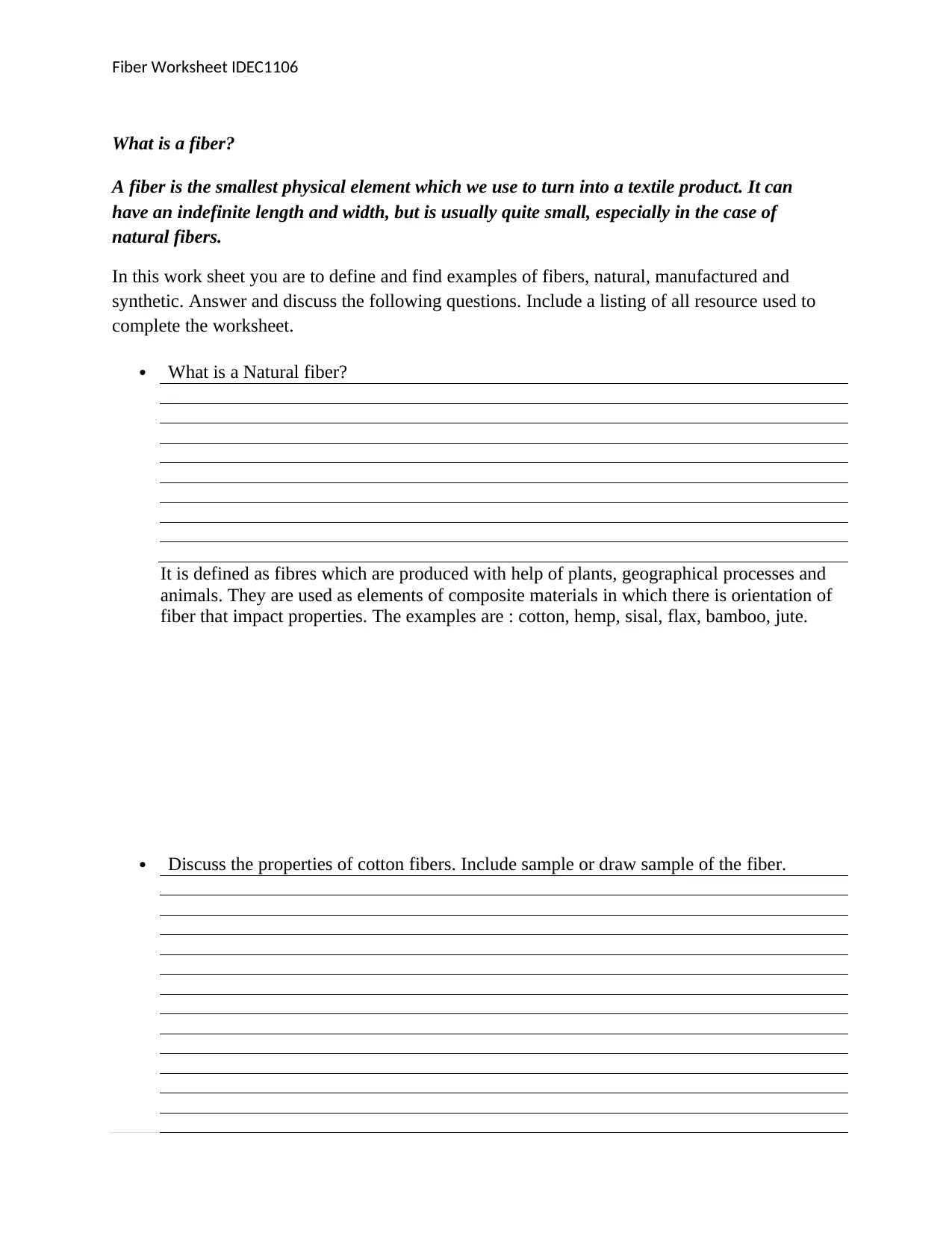
Fiber Worksheet IDEC1106
What is a fiber?
A fiber is the smallest physical element which we use to turn into a textile product. It can
have an indefinite length and width, but is usually quite small, especially in the case of
natural fibers.
In this work sheet you are to define and find examples of fibers, natural, manufactured and
synthetic. Answer and discuss the following questions. Include a listing of all resource used to
complete the worksheet.
What is a Natural fiber?
It is defined as fibres which are produced with help of plants, geographical processes and
animals. They are used as elements of composite materials in which there is orientation of
fiber that impact properties. The examples are : cotton, hemp, sisal, flax, bamboo, jute.
Discuss the properties of cotton fibers. Include sample or draw sample of the fiber.
What is a fiber?
A fiber is the smallest physical element which we use to turn into a textile product. It can
have an indefinite length and width, but is usually quite small, especially in the case of
natural fibers.
In this work sheet you are to define and find examples of fibers, natural, manufactured and
synthetic. Answer and discuss the following questions. Include a listing of all resource used to
complete the worksheet.
What is a Natural fiber?
It is defined as fibres which are produced with help of plants, geographical processes and
animals. They are used as elements of composite materials in which there is orientation of
fiber that impact properties. The examples are : cotton, hemp, sisal, flax, bamboo, jute.
Discuss the properties of cotton fibers. Include sample or draw sample of the fiber.
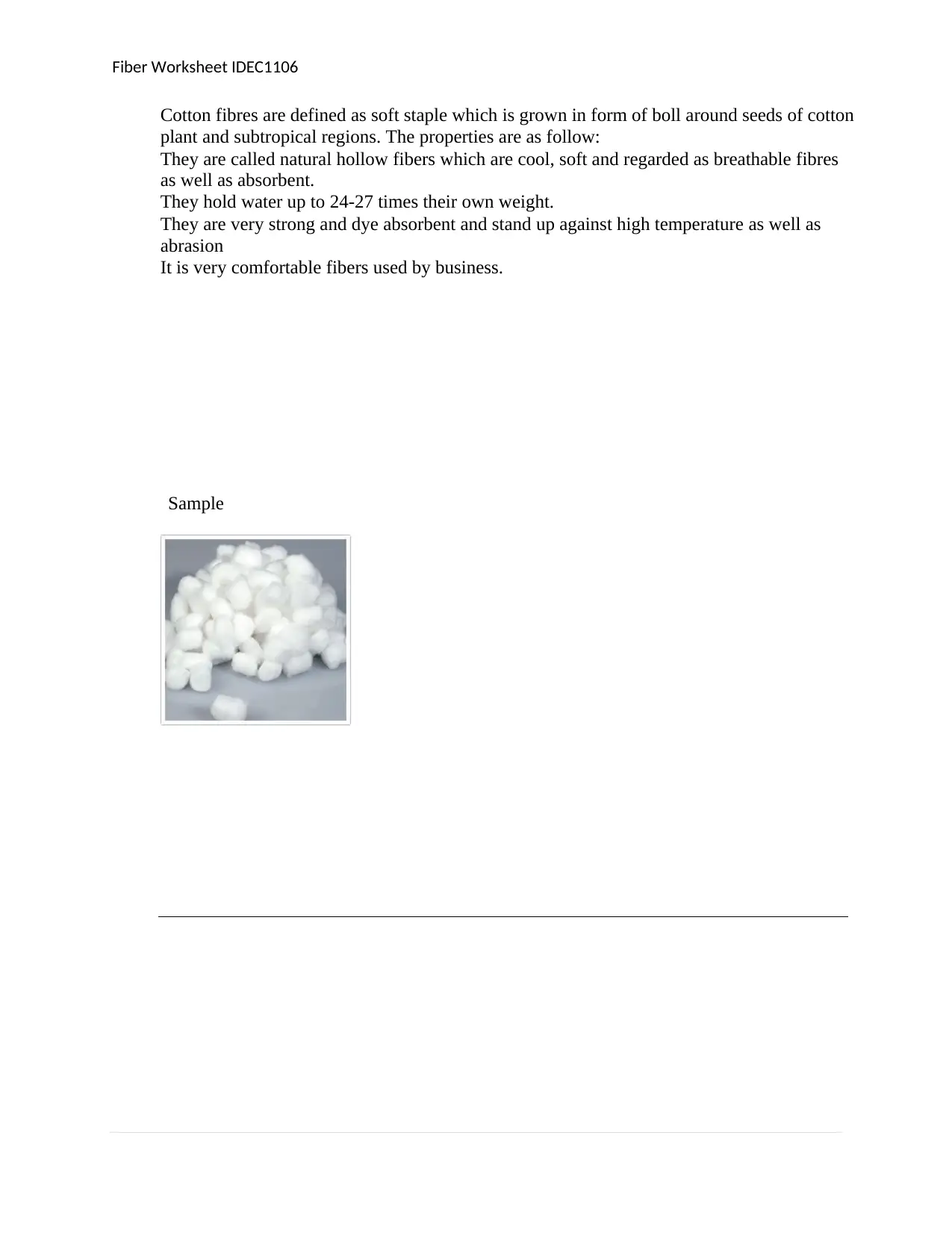
Fiber Worksheet IDEC1106
Cotton fibres are defined as soft staple which is grown in form of boll around seeds of cotton
plant and subtropical regions. The properties are as follow:
They are called natural hollow fibers which are cool, soft and regarded as breathable fibres
as well as absorbent.
They hold water up to 24-27 times their own weight.
They are very strong and dye absorbent and stand up against high temperature as well as
abrasion
It is very comfortable fibers used by business.
Sample
Cotton fibres are defined as soft staple which is grown in form of boll around seeds of cotton
plant and subtropical regions. The properties are as follow:
They are called natural hollow fibers which are cool, soft and regarded as breathable fibres
as well as absorbent.
They hold water up to 24-27 times their own weight.
They are very strong and dye absorbent and stand up against high temperature as well as
abrasion
It is very comfortable fibers used by business.
Sample
⊘ This is a preview!⊘
Do you want full access?
Subscribe today to unlock all pages.

Trusted by 1+ million students worldwide
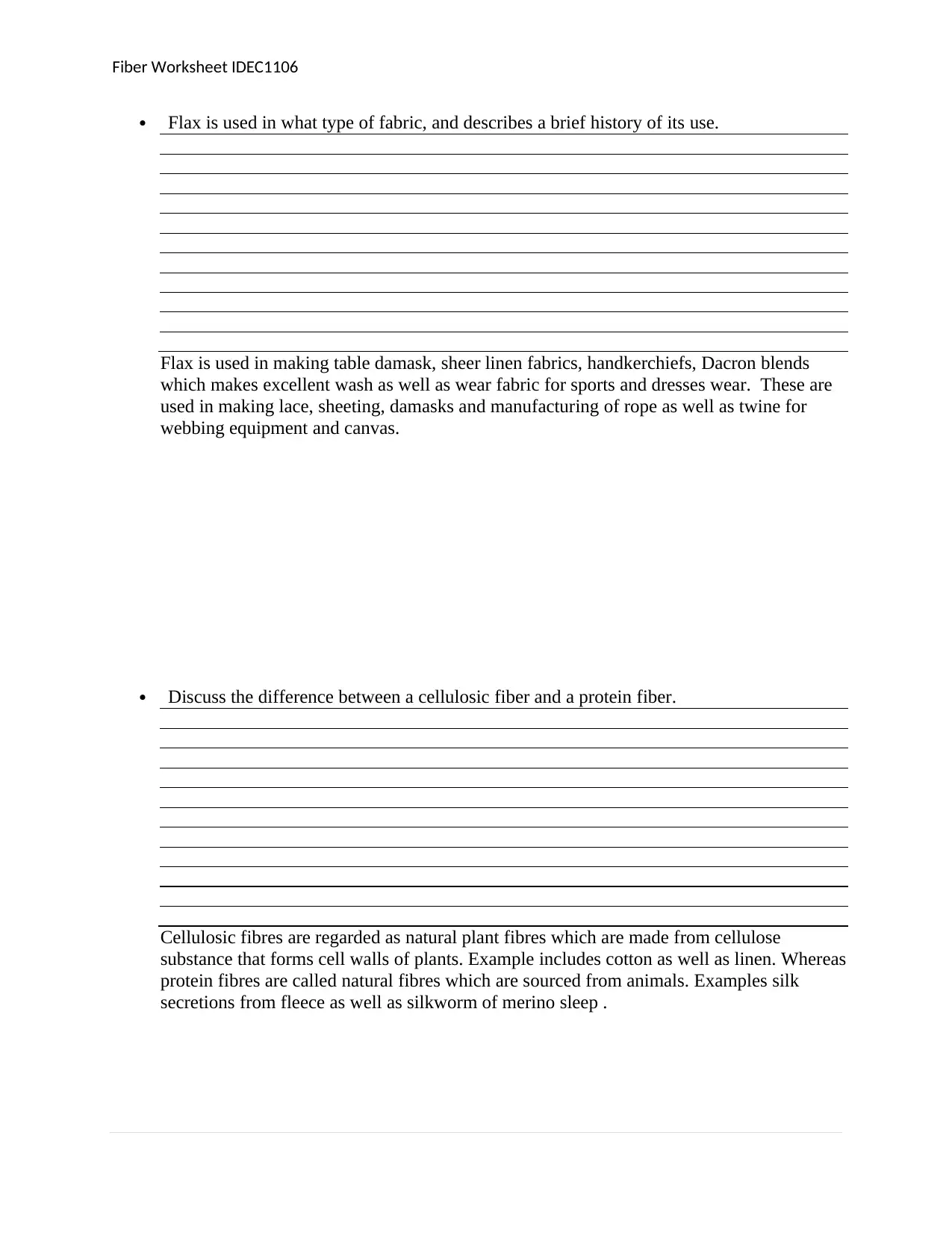
Fiber Worksheet IDEC1106
Flax is used in what type of fabric, and describes a brief history of its use.
Flax is used in making table damask, sheer linen fabrics, handkerchiefs, Dacron blends
which makes excellent wash as well as wear fabric for sports and dresses wear. These are
used in making lace, sheeting, damasks and manufacturing of rope as well as twine for
webbing equipment and canvas.
Discuss the difference between a cellulosic fiber and a protein fiber.
Cellulosic fibres are regarded as natural plant fibres which are made from cellulose
substance that forms cell walls of plants. Example includes cotton as well as linen. Whereas
protein fibres are called natural fibres which are sourced from animals. Examples silk
secretions from fleece as well as silkworm of merino sleep .
Flax is used in what type of fabric, and describes a brief history of its use.
Flax is used in making table damask, sheer linen fabrics, handkerchiefs, Dacron blends
which makes excellent wash as well as wear fabric for sports and dresses wear. These are
used in making lace, sheeting, damasks and manufacturing of rope as well as twine for
webbing equipment and canvas.
Discuss the difference between a cellulosic fiber and a protein fiber.
Cellulosic fibres are regarded as natural plant fibres which are made from cellulose
substance that forms cell walls of plants. Example includes cotton as well as linen. Whereas
protein fibres are called natural fibres which are sourced from animals. Examples silk
secretions from fleece as well as silkworm of merino sleep .
Paraphrase This Document
Need a fresh take? Get an instant paraphrase of this document with our AI Paraphraser
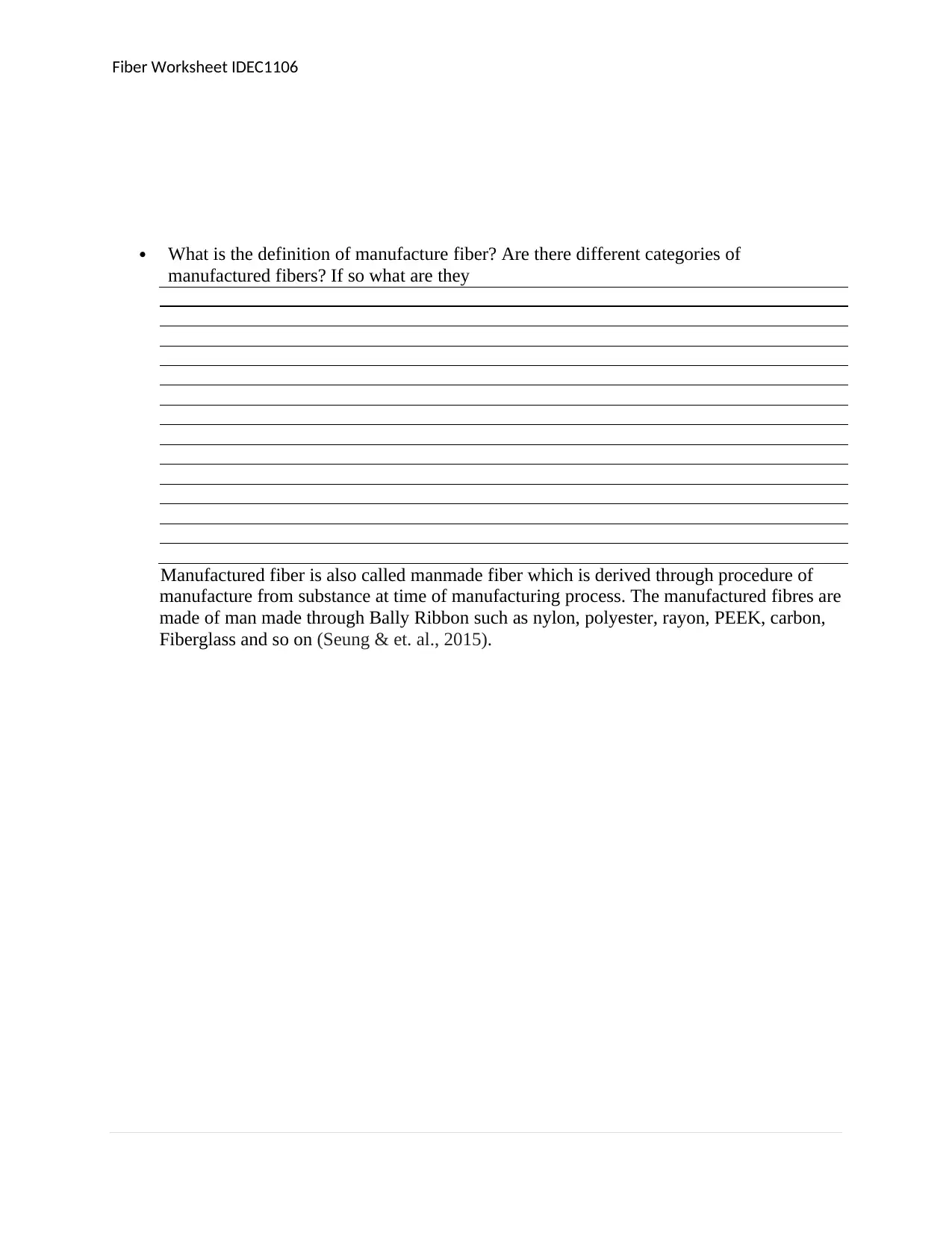
Fiber Worksheet IDEC1106
What is the definition of manufacture fiber? Are there different categories of
manufactured fibers? If so what are they
Manufactured fiber is also called manmade fiber which is derived through procedure of
manufacture from substance at time of manufacturing process. The manufactured fibres are
made of man made through Bally Ribbon such as nylon, polyester, rayon, PEEK, carbon,
Fiberglass and so on (Seung & et. al., 2015).
What is the definition of manufacture fiber? Are there different categories of
manufactured fibers? If so what are they
Manufactured fiber is also called manmade fiber which is derived through procedure of
manufacture from substance at time of manufacturing process. The manufactured fibres are
made of man made through Bally Ribbon such as nylon, polyester, rayon, PEEK, carbon,
Fiberglass and so on (Seung & et. al., 2015).
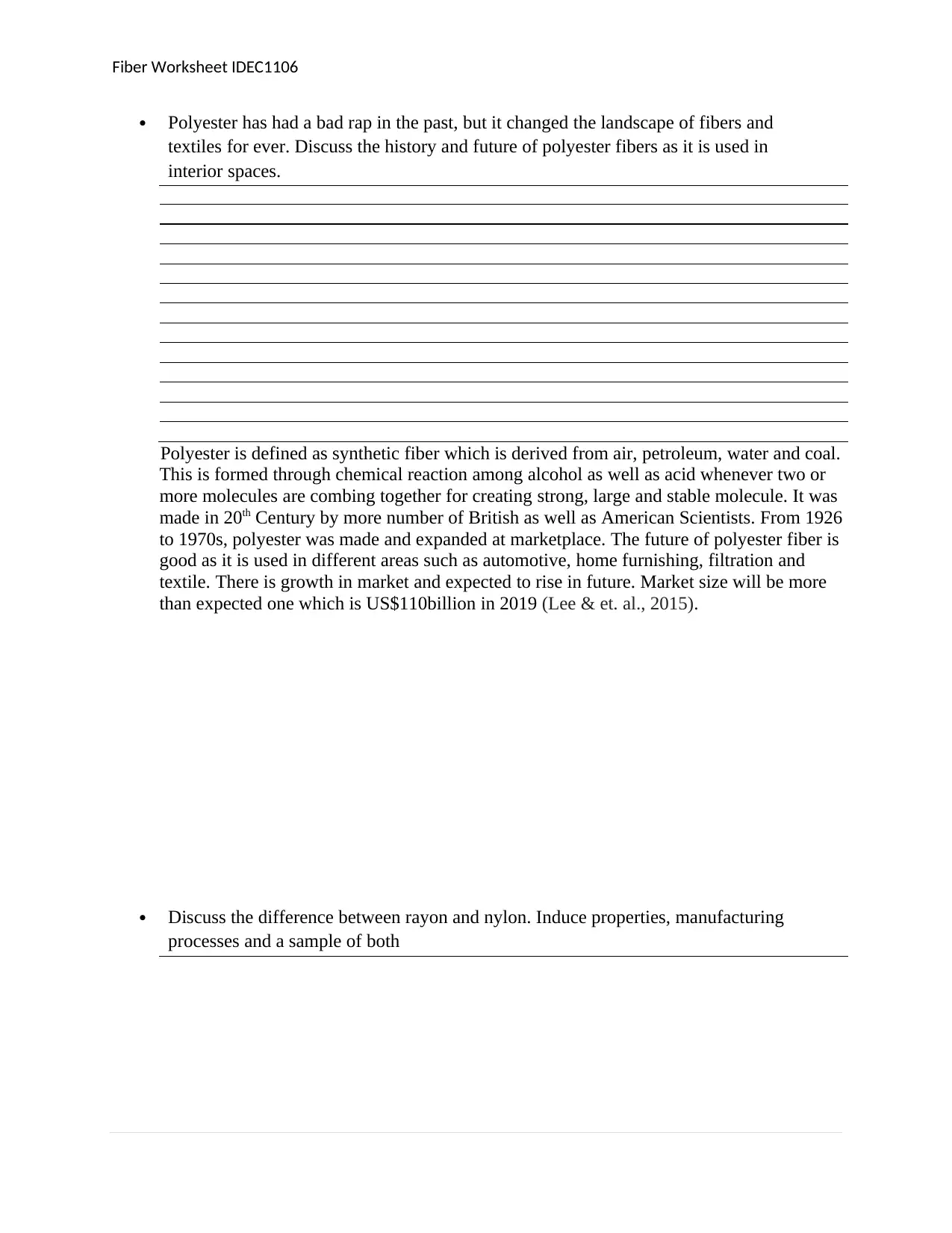
Fiber Worksheet IDEC1106
Polyester has had a bad rap in the past, but it changed the landscape of fibers and
textiles for ever. Discuss the history and future of polyester fibers as it is used in
interior spaces.
Polyester is defined as synthetic fiber which is derived from air, petroleum, water and coal.
This is formed through chemical reaction among alcohol as well as acid whenever two or
more molecules are combing together for creating strong, large and stable molecule. It was
made in 20th Century by more number of British as well as American Scientists. From 1926
to 1970s, polyester was made and expanded at marketplace. The future of polyester fiber is
good as it is used in different areas such as automotive, home furnishing, filtration and
textile. There is growth in market and expected to rise in future. Market size will be more
than expected one which is US$110billion in 2019 (Lee & et. al., 2015).
Discuss the difference between rayon and nylon. Induce properties, manufacturing
processes and a sample of both
Polyester has had a bad rap in the past, but it changed the landscape of fibers and
textiles for ever. Discuss the history and future of polyester fibers as it is used in
interior spaces.
Polyester is defined as synthetic fiber which is derived from air, petroleum, water and coal.
This is formed through chemical reaction among alcohol as well as acid whenever two or
more molecules are combing together for creating strong, large and stable molecule. It was
made in 20th Century by more number of British as well as American Scientists. From 1926
to 1970s, polyester was made and expanded at marketplace. The future of polyester fiber is
good as it is used in different areas such as automotive, home furnishing, filtration and
textile. There is growth in market and expected to rise in future. Market size will be more
than expected one which is US$110billion in 2019 (Lee & et. al., 2015).
Discuss the difference between rayon and nylon. Induce properties, manufacturing
processes and a sample of both
⊘ This is a preview!⊘
Do you want full access?
Subscribe today to unlock all pages.

Trusted by 1+ million students worldwide
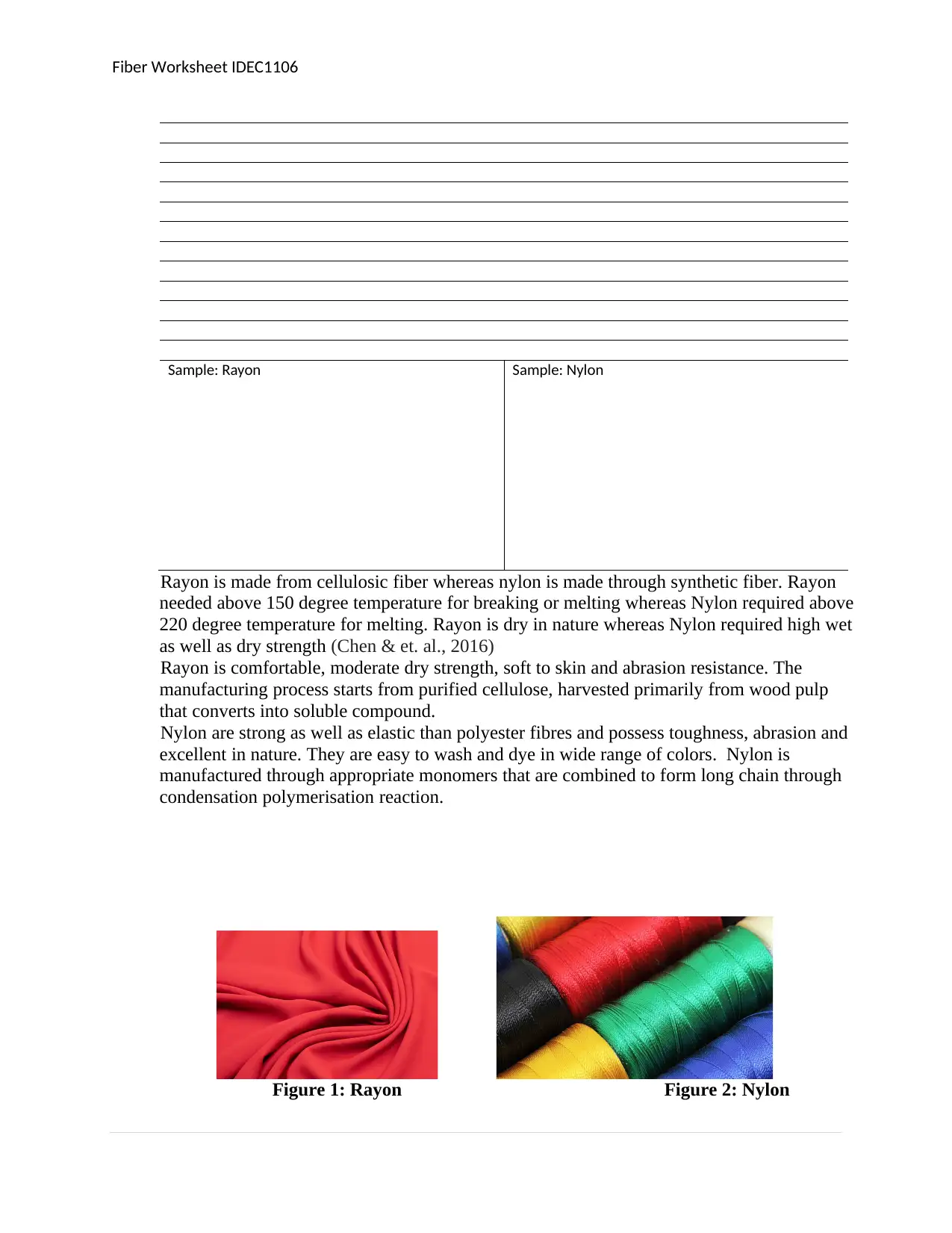
Fiber Worksheet IDEC1106
Rayon is made from cellulosic fiber whereas nylon is made through synthetic fiber. Rayon
needed above 150 degree temperature for breaking or melting whereas Nylon required above
220 degree temperature for melting. Rayon is dry in nature whereas Nylon required high wet
as well as dry strength (Chen & et. al., 2016)
Rayon is comfortable, moderate dry strength, soft to skin and abrasion resistance. The
manufacturing process starts from purified cellulose, harvested primarily from wood pulp
that converts into soluble compound.
Nylon are strong as well as elastic than polyester fibres and possess toughness, abrasion and
excellent in nature. They are easy to wash and dye in wide range of colors. Nylon is
manufactured through appropriate monomers that are combined to form long chain through
condensation polymerisation reaction.
Figure 1: Rayon Figure 2: Nylon
Sample: Rayon Sample: Nylon
Rayon is made from cellulosic fiber whereas nylon is made through synthetic fiber. Rayon
needed above 150 degree temperature for breaking or melting whereas Nylon required above
220 degree temperature for melting. Rayon is dry in nature whereas Nylon required high wet
as well as dry strength (Chen & et. al., 2016)
Rayon is comfortable, moderate dry strength, soft to skin and abrasion resistance. The
manufacturing process starts from purified cellulose, harvested primarily from wood pulp
that converts into soluble compound.
Nylon are strong as well as elastic than polyester fibres and possess toughness, abrasion and
excellent in nature. They are easy to wash and dye in wide range of colors. Nylon is
manufactured through appropriate monomers that are combined to form long chain through
condensation polymerisation reaction.
Figure 1: Rayon Figure 2: Nylon
Sample: Rayon Sample: Nylon
Paraphrase This Document
Need a fresh take? Get an instant paraphrase of this document with our AI Paraphraser
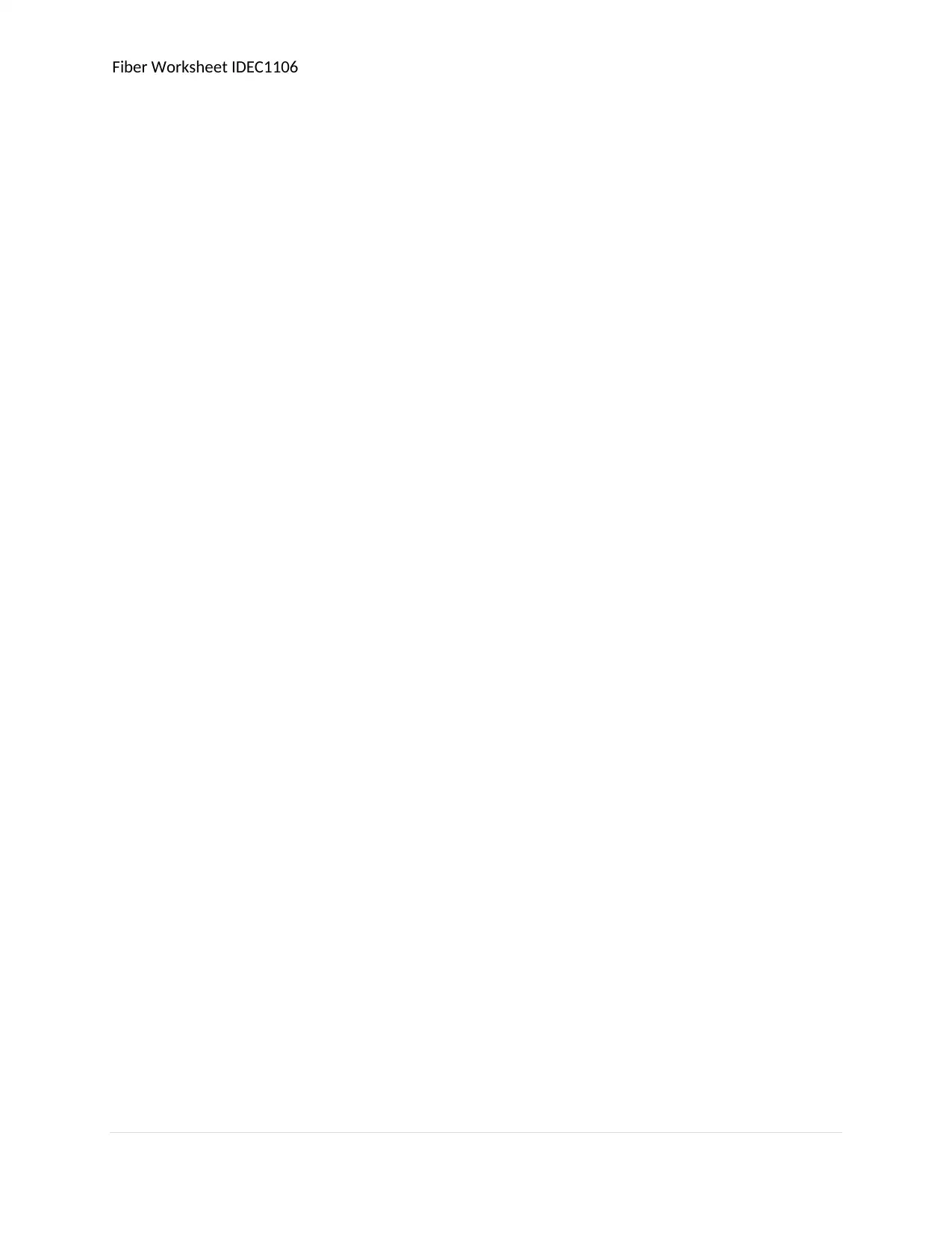
Fiber Worksheet IDEC1106
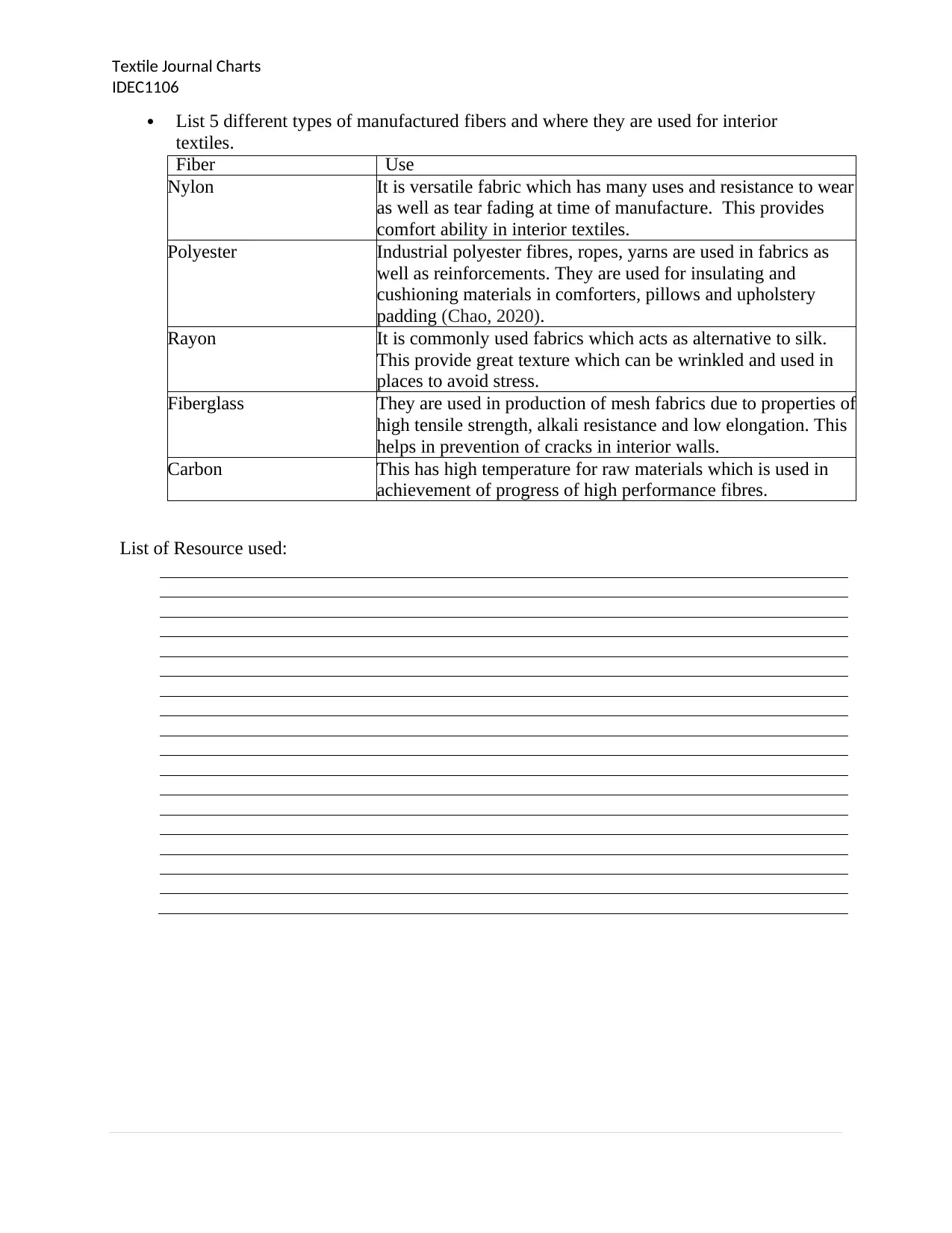
Textile Journal Charts
IDEC1106
List 5 different types of manufactured fibers and where they are used for interior
textiles.
Fiber Use
Nylon It is versatile fabric which has many uses and resistance to wear
as well as tear fading at time of manufacture. This provides
comfort ability in interior textiles.
Polyester Industrial polyester fibres, ropes, yarns are used in fabrics as
well as reinforcements. They are used for insulating and
cushioning materials in comforters, pillows and upholstery
padding (Chao, 2020).
Rayon It is commonly used fabrics which acts as alternative to silk.
This provide great texture which can be wrinkled and used in
places to avoid stress.
Fiberglass They are used in production of mesh fabrics due to properties of
high tensile strength, alkali resistance and low elongation. This
helps in prevention of cracks in interior walls.
Carbon This has high temperature for raw materials which is used in
achievement of progress of high performance fibres.
List of Resource used:
IDEC1106
List 5 different types of manufactured fibers and where they are used for interior
textiles.
Fiber Use
Nylon It is versatile fabric which has many uses and resistance to wear
as well as tear fading at time of manufacture. This provides
comfort ability in interior textiles.
Polyester Industrial polyester fibres, ropes, yarns are used in fabrics as
well as reinforcements. They are used for insulating and
cushioning materials in comforters, pillows and upholstery
padding (Chao, 2020).
Rayon It is commonly used fabrics which acts as alternative to silk.
This provide great texture which can be wrinkled and used in
places to avoid stress.
Fiberglass They are used in production of mesh fabrics due to properties of
high tensile strength, alkali resistance and low elongation. This
helps in prevention of cracks in interior walls.
Carbon This has high temperature for raw materials which is used in
achievement of progress of high performance fibres.
List of Resource used:
⊘ This is a preview!⊘
Do you want full access?
Subscribe today to unlock all pages.

Trusted by 1+ million students worldwide
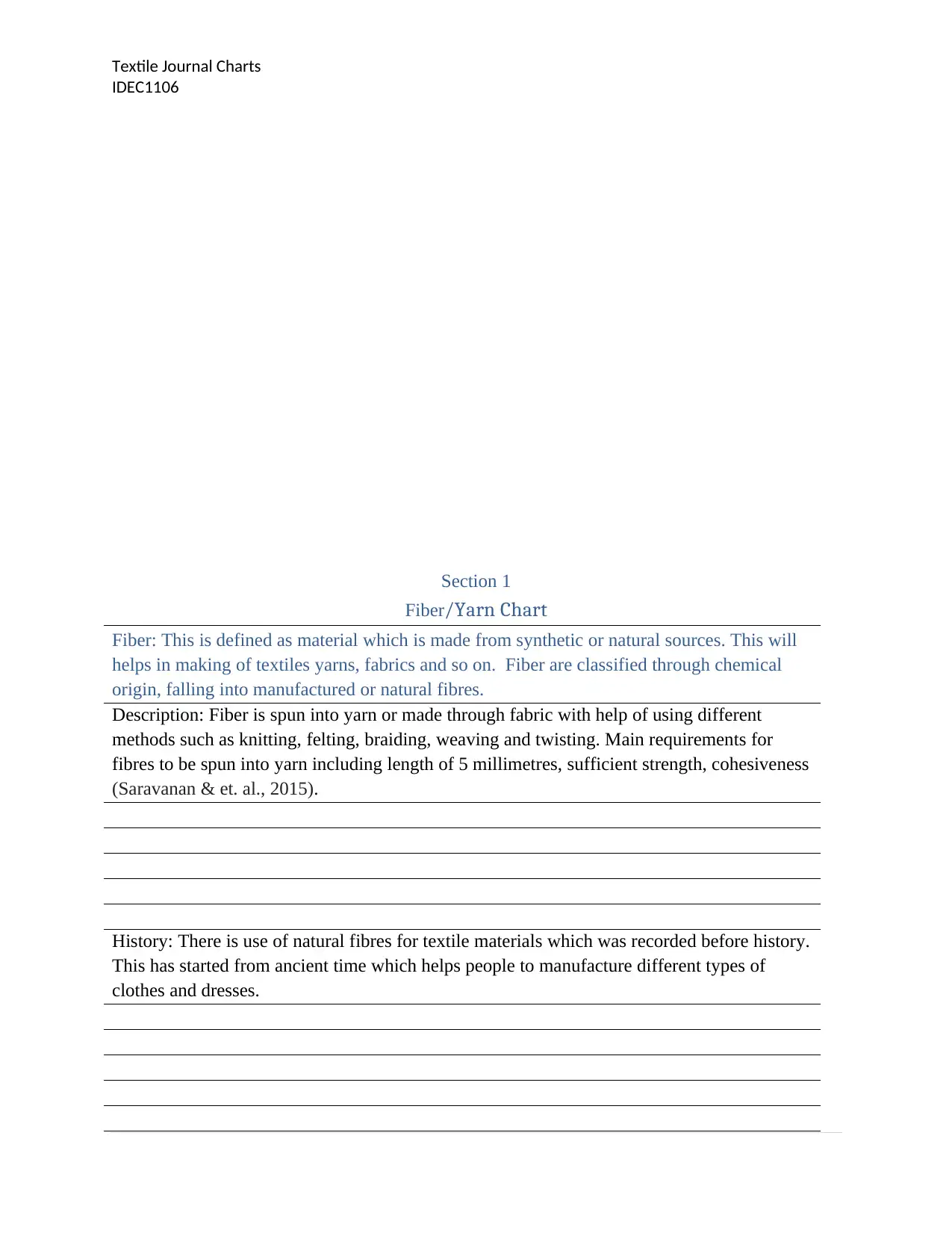
Textile Journal Charts
IDEC1106
Section 1
Fiber/Yarn Chart
Fiber: This is defined as material which is made from synthetic or natural sources. This will
helps in making of textiles yarns, fabrics and so on. Fiber are classified through chemical
origin, falling into manufactured or natural fibres.
Description: Fiber is spun into yarn or made through fabric with help of using different
methods such as knitting, felting, braiding, weaving and twisting. Main requirements for
fibres to be spun into yarn including length of 5 millimetres, sufficient strength, cohesiveness
(Saravanan & et. al., 2015).
History: There is use of natural fibres for textile materials which was recorded before history.
This has started from ancient time which helps people to manufacture different types of
clothes and dresses.
IDEC1106
Section 1
Fiber/Yarn Chart
Fiber: This is defined as material which is made from synthetic or natural sources. This will
helps in making of textiles yarns, fabrics and so on. Fiber are classified through chemical
origin, falling into manufactured or natural fibres.
Description: Fiber is spun into yarn or made through fabric with help of using different
methods such as knitting, felting, braiding, weaving and twisting. Main requirements for
fibres to be spun into yarn including length of 5 millimetres, sufficient strength, cohesiveness
(Saravanan & et. al., 2015).
History: There is use of natural fibres for textile materials which was recorded before history.
This has started from ancient time which helps people to manufacture different types of
clothes and dresses.
Paraphrase This Document
Need a fresh take? Get an instant paraphrase of this document with our AI Paraphraser
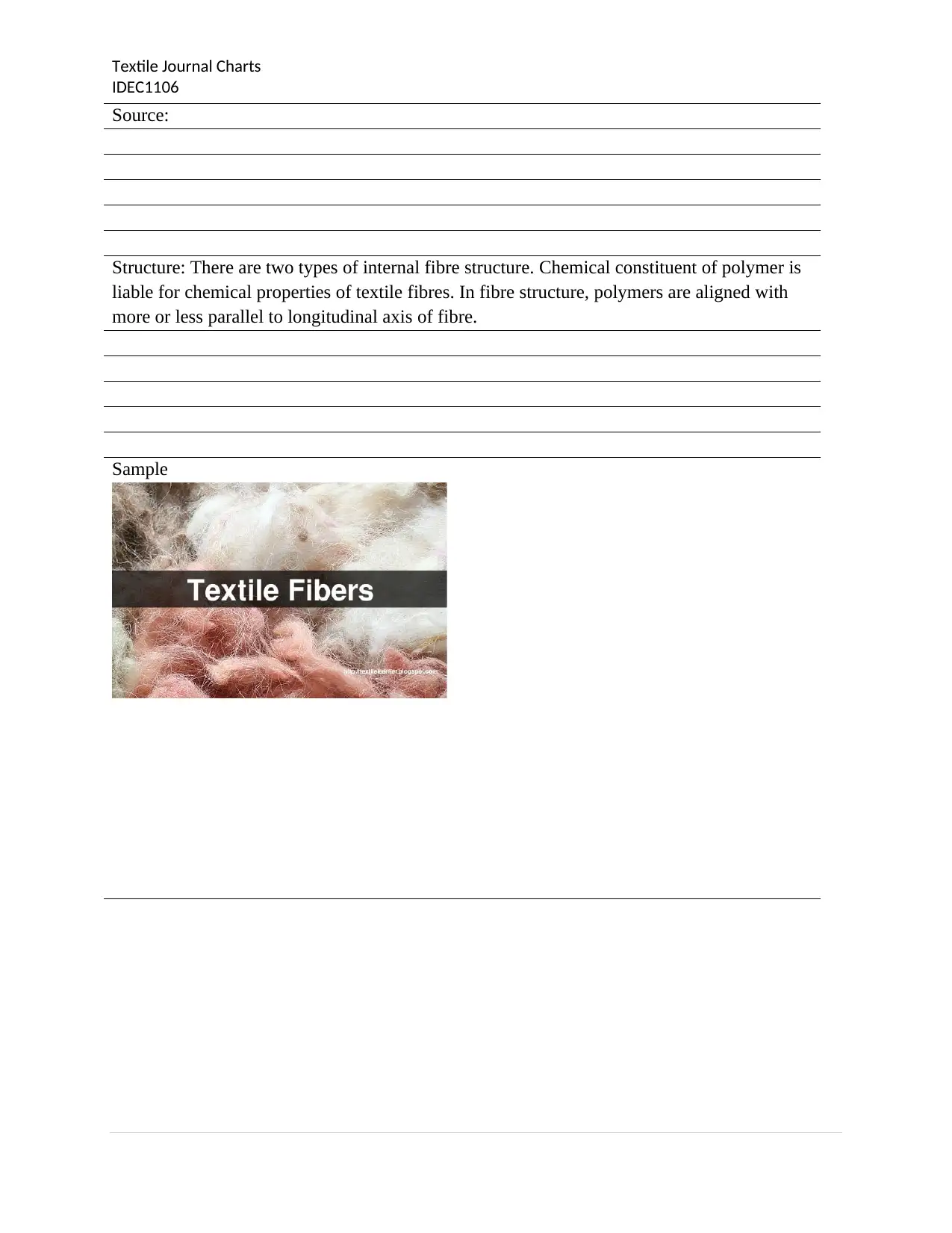
Textile Journal Charts
IDEC1106
Source:
Structure: There are two types of internal fibre structure. Chemical constituent of polymer is
liable for chemical properties of textile fibres. In fibre structure, polymers are aligned with
more or less parallel to longitudinal axis of fibre.
Sample
IDEC1106
Source:
Structure: There are two types of internal fibre structure. Chemical constituent of polymer is
liable for chemical properties of textile fibres. In fibre structure, polymers are aligned with
more or less parallel to longitudinal axis of fibre.
Sample
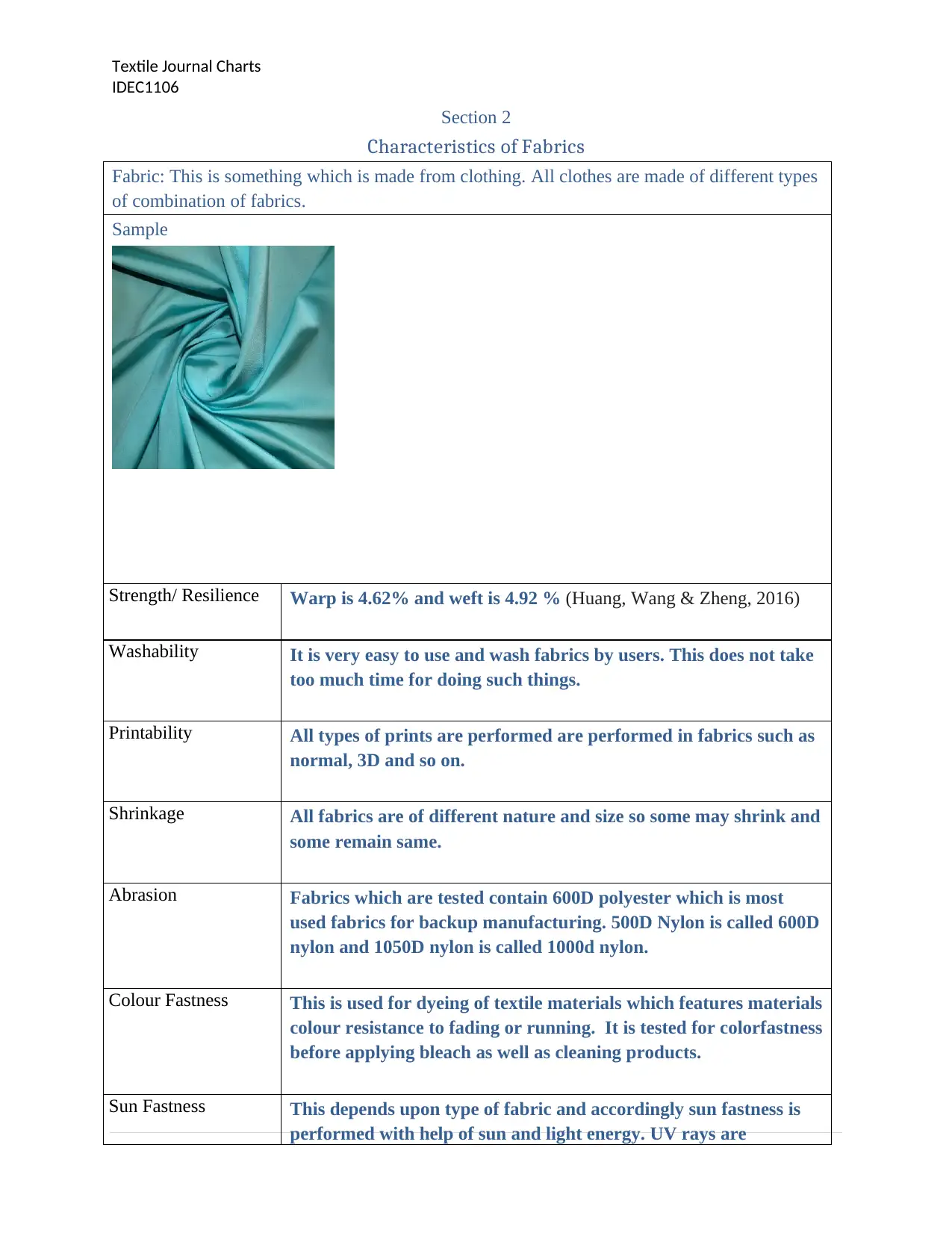
Textile Journal Charts
IDEC1106
Section 2
Characteristics of Fabrics
Fabric: This is something which is made from clothing. All clothes are made of different types
of combination of fabrics.
Sample
Strength/ Resilience Warp is 4.62% and weft is 4.92 % (Huang, Wang & Zheng, 2016)
Washability It is very easy to use and wash fabrics by users. This does not take
too much time for doing such things.
Printability All types of prints are performed are performed in fabrics such as
normal, 3D and so on.
Shrinkage All fabrics are of different nature and size so some may shrink and
some remain same.
Abrasion Fabrics which are tested contain 600D polyester which is most
used fabrics for backup manufacturing. 500D Nylon is called 600D
nylon and 1050D nylon is called 1000d nylon.
Colour Fastness This is used for dyeing of textile materials which features materials
colour resistance to fading or running. It is tested for colorfastness
before applying bleach as well as cleaning products.
Sun Fastness This depends upon type of fabric and accordingly sun fastness is
performed with help of sun and light energy. UV rays are
IDEC1106
Section 2
Characteristics of Fabrics
Fabric: This is something which is made from clothing. All clothes are made of different types
of combination of fabrics.
Sample
Strength/ Resilience Warp is 4.62% and weft is 4.92 % (Huang, Wang & Zheng, 2016)
Washability It is very easy to use and wash fabrics by users. This does not take
too much time for doing such things.
Printability All types of prints are performed are performed in fabrics such as
normal, 3D and so on.
Shrinkage All fabrics are of different nature and size so some may shrink and
some remain same.
Abrasion Fabrics which are tested contain 600D polyester which is most
used fabrics for backup manufacturing. 500D Nylon is called 600D
nylon and 1050D nylon is called 1000d nylon.
Colour Fastness This is used for dyeing of textile materials which features materials
colour resistance to fading or running. It is tested for colorfastness
before applying bleach as well as cleaning products.
Sun Fastness This depends upon type of fabric and accordingly sun fastness is
performed with help of sun and light energy. UV rays are
⊘ This is a preview!⊘
Do you want full access?
Subscribe today to unlock all pages.

Trusted by 1+ million students worldwide
1 out of 19
Your All-in-One AI-Powered Toolkit for Academic Success.
+13062052269
info@desklib.com
Available 24*7 on WhatsApp / Email
![[object Object]](/_next/static/media/star-bottom.7253800d.svg)
Unlock your academic potential
Copyright © 2020–2025 A2Z Services. All Rights Reserved. Developed and managed by ZUCOL.
